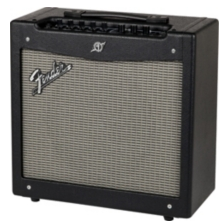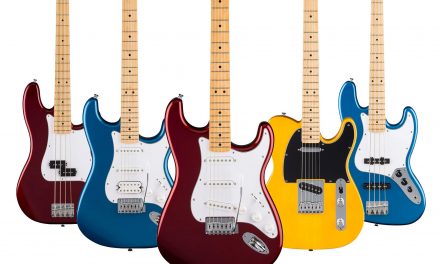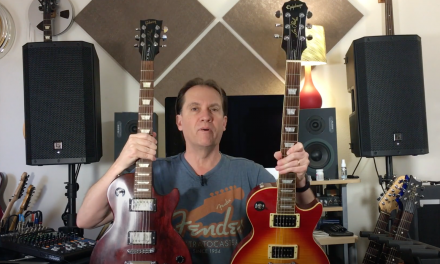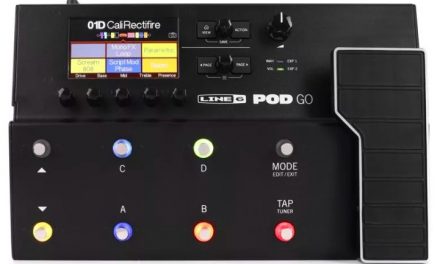After that huge post discussing practicing and jamming amps, it has taken me forever to sit down and talk about the next part – recording and performing amps. Professional guitar players wouldn’t be reading this post, unless it’s for my witty prose, because they’ve already got their setups nailed down. If you’re Phil X, you have your own gear and sound. But if you’re new to recording and/or performing, this post may be helpful.
Recording
The good and bad news is that there are a billion ways to record your guitar. So let’s put them into basic categories and discuss the pros and cons of each:
- Software (no amp at all.) Your computer DAW (Digital Audio Workstation, ie recording software,) whether it is GarageBand or something more sophisticated, has the ability to simulate amps. If you want to spend more money for something better, there are dedicated software products like Amplitube that you can install. This gives you a ton of control over your sound, and since your guitar is recorded totally clean, you can change your mind as often as you want and try out different sounds. However, guitarists who slave over their tone will normally like the sound of a real amp as opposed to an imitation of it.
- Software in Hardware. You can buy a pedal board or rack mount unit that runs amp simulation on dedicated hardware and outputs into your DAW. The advantage of this is that some people prefer the sounds of a dedicated hardware device to software such as Amplitube. Some guitarists gig with a Line 6 Floor Pod (there are lots to choose from) and the guitar sound goes right to the house mixer. In this way, you can have your live sound identical to your recorded sound mostly. On the high end you’ve got multi-thousand dollar boxes that output something that is so close to the real thing it can fool experts. But 3 thousand dollar boxes don’t exist in the Budget Guitarist universe, so forget that. However, today’s 3 thousand dollar technology is tomorrow’s three hundred dollar technology. Simulators, in #1 or #2 format, will continue to get better.
- Software in Amp. So here’s where we have the modeling amps like the Fender Mustang 2. Is this really just the Amplitube amp simulations running on custom chips and fed to a Fender solid state amp? To oversimplify, yes. It might not actually BE the actual software Amplitube makes (or it might,) but that’s the concept. Modeling amps usually have a USB output where you can record the simulations straight into your computer. Really this is just a play on #2, but you get a guitar speaker. If you want to, you can mic the guitar speaker instead of using the USB out. It will sound different than the USB signal. Whether you like it better is up to your ears.
- Actual amp with cabinet emulation. This is where my own amp (Peavey Valveking Micro-head) fits in. These are tube (or solid state) amps that have a direct output on them suitable for recording, and the amp sound is not modeled – it’s the actual sound of the amp – but the software in the amp emulates the sound of a speaker. The resulting output sounds more like a cabinet with a microphone in front of it than if you just recorded the amp signal clean, which usually produces a sterile, flat sound with little life to it. How does it sound? Some people like it, some don’t. It depends on the amp and the sound you want.
- Actual amp with speaker, with a microphone. And finally, what a lot of pro guitarists do in the studio is to stick a mic (usually a Shure SM57) in front of their amp’s speaker and be done with it. Sometimes they use more than one mic, sometimes they use mics in the room to capture the room sound in addition to the cab mic, but the concept is to make the amp sound as good as possible and then capture that sound with a mic. When done well, it can sound amazing.
So for a budget guitarist who wants a great guitar sound, what’s best? I can’t tell you because guitar tone is so highly subjective. But here are some things to think about:
- Software amp models in your DAW almost always suck. If you are OK with the sound of them, go with that because it’s the simplest way to record.
- Software will have you dealing with latency. This means a small delay between hitting a note and hearing it come out of the speaker. If you have a kick ass computer and you don’t mind tweaking settings, you can get around this. Otherwise, avoid #1.
- There’s nothing like playing through an actual amp, even a modeling amp. Before you go with 1 or 2, be sure you don’t have a problem playing through a non-amp.
- Using a direct output from 2 – 4 will not give you a super accurate sound, but it can often be the best sound you’re likely to get, unless you have a fantastic sounding tube amp and a knowledge of how to record amp speakers with a microphone.
- If you’re going to try using a cabinet and a mic, make sure you can crank the volume on the cab. Bedroom volume levels do not create the greatest sound capture in a mic – turning the amp up loud will usually result in a better recording.
- Try everything at your disposal and let your ears be the judge. You might get the best results running your Floor Pod into your Mustang II and putting a mic on the cabinet. Who knows? Only you know what sounds you like, so experiment.
Performing
Now we get to performing. I won’t rehash the amp models again, but there’s one thing you really need to know – the amp you select should meet the needs of the size of the gig. I’ve talked about how an entry-level Line 6 amp is not a good choice for performing because it doesn’t sound good at loud volumes, but in reality if you do not require loud volumes it would be fine. If you’re playing jazz or singer-songwriter at a venue where you are background music, almost anything will work.
But another thing to consider is portability. Unless you have a roady, you’re going to be lifting and carrying your amp. If you’re 50 and have lower back issues, you might gig with a Floor Pod or similar device, and go through the PA for your sound. I’ve done that many times and it can work out very well. If you are using any PA, whether big or small, think about going direct with a hardware device that emulates amps.
However, just like with recording, the best guitar sounds are going to come from a real guitar amp, usually with tubes. If you don’t think the emulation stuff is good enough, think about the type of amp you want to have to carry around. Without live drums, you can get away with a small combo amp with a 10 or 12 inch speaker. With a live drummer, um… it depends on the drummer. A 15 watt tube amp might be enough. A 20 or 30 watt tube amp might be a better choice. In terms of speakers, lots of guys gig with a single twelve, two tens, two twelves, and in some cases four tens. Yes, there are cabs with four twelves, such as the infamous Marshall stack. And if you want to cart around something that big and heavy, more power to you. But the only place where you actually need all of those speakers is at huge venues, in which case you’re not reading this post. Unless it’s for, you know.
Conclusion – None of this matters and you should use your ears. But think about all of the variables. I would ALWAYS prefer to play through a tube guitar amp, but sometimes I’ll use a Floor Pod myself just for the convenience of the gig, if the gig is background music.
And as you may have noticed, there’s no comment section. This is because there are a lot of guitar players out there who love to argue and debate every single point of everyone’s opinions. Usually things get very high school. Not here. You can read my posts or not. Totally up to you. But no one is going to create a negative environment here. I’m just writing and sharing what I know. If you don’t like it, you can start your own website. It’s pretty easy.





